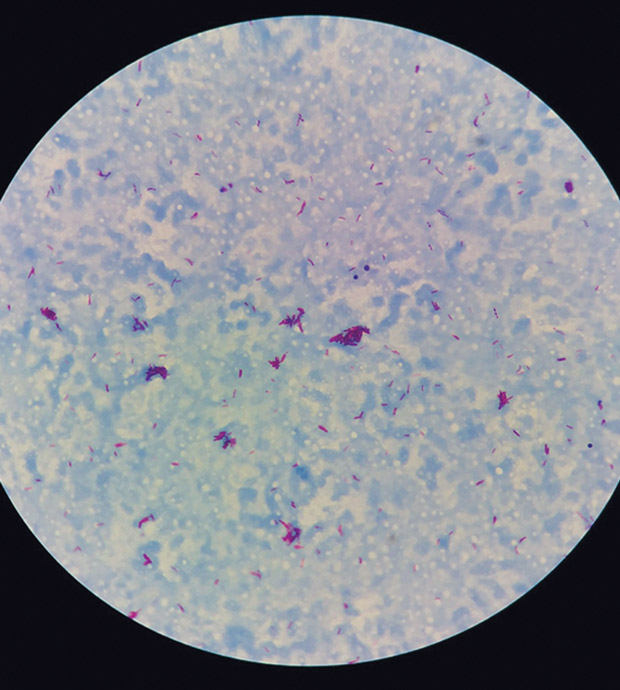MKSAP Quiz: 6-week history of weight loss
A 24-year-old woman is evaluated for a 6-week history of weight loss, fever, night sweats, and productive cough, with recently increasing malaise and fatigue. She works in a state prison. She takes no medications.

On physical examination, temperature is 38.6 °C (101.5 °F); other vital signs are normal. Pulmonary examination reveals bronchial breath sounds bilaterally over the posterior upper lung lobes.
Chest radiograph shows a small cavity with infiltrates in the right and left upper lobes and hilar lymphadenopathy.
Sputum acid-fast bacilli stain is shown. Sputum culture is pending.
Which of the following is the most appropriate initial treatment?
A. Clarithromycin and ethambutol
B. Isoniazid
C. Isoniazid, rifampin, pyrazinamide, and ethambutol
D. Rifampin, ethambutol, pyrazinamide, and levofloxacin
Answer and critique
The correct answer is C. Isoniazid, rifampin, pyrazinamide, and ethambutol. This item is Question 23 in MKSAP 19's Infectious Disease section.
The patient has active pulmonary tuberculosis requiring treatment with the four-drug tuberculosis treatment regimen (isoniazid, rifampin, pyrazinamide, ethambutol) (Option C). Although a tuberculin skin test has not been performed and the final sputum culture is pending, the patient has a significant personal history that increases her risk of tuberculosis; she works in a high-risk setting (prison). She has several key symptoms and signs of pulmonary tuberculosis, including weight loss, fever, night sweats, productive cough, malaise, and fatigue; the chest radiograph is compatible with active tuberculosis, and she has a classic sputum acid-fast bacilli (AFB) stain. When a sputum smear result is positive for AFB, nucleic acid amplification testing (NAAT) is highly recommended to verify the organism. The positive predictive value of a NAAT on a smear-positive sputum sample is 95%. When active tuberculosis is verified, in vitro susceptibility testing of the initial isolate should be done for the first-line agents (isoniazid, rifampin, pyrazinamide, and ethambutol) which should be initiated as soon as possible to prevent further disease progression and transmission.
Clarithromycin and ethambutol (Option A) is the preferred regimen for Mycobacterium avium complex, not Mycobacterium tuberculosis. This would be insufficient treatment for M. tuberculosis infection.
Although it is one of the antimicrobials used to treat tuberculosis, isoniazid alone (Option B) is not indicated for active tuberculosis. It is only indicated as monotherapy for treatment of latent tuberculosis. Isoniazid monotherapy in active tuberculosis could promote the development of isoniazid resistance.
In the United States, the incidence of isoniazid resistance ranges from 4.7% to 14.4%; global resistance rates are higher. The regimen of rifampin, ethambutol, pyrazinamide, and levofloxacin (Option D) is a safe and reasonable option for patients with proven isoniazid resistance. At this time, the patient has no indication of isoniazid resistance, and isoniazid, rifampin, pyrazinamide, and ethambutol is guideline recommended as first-line therapy.
Key Point
- When active tuberculosis is verified, in vitro susceptibility testing of the initial isolate should be done for the first-line agents (isoniazid, rifampin, pyrazinamide, and ethambutol), which should be started as soon as possible.
Subscribe to MKSAP 19
ACP's MKSAP helps you to:
- Update your knowledge in all areas of internal medicine
- Assess your medical knowledge with 1,200 all-new multiple-choice questions
- Pass the ABIM Certification Exam or the ABIM Recertification Exam
- Support your clinical decisions in practice
To order the most current edition, go online.



